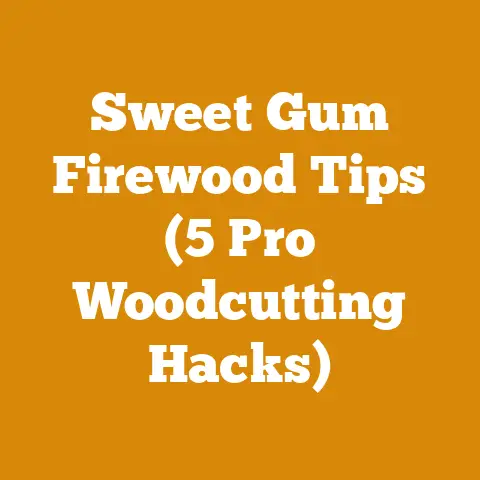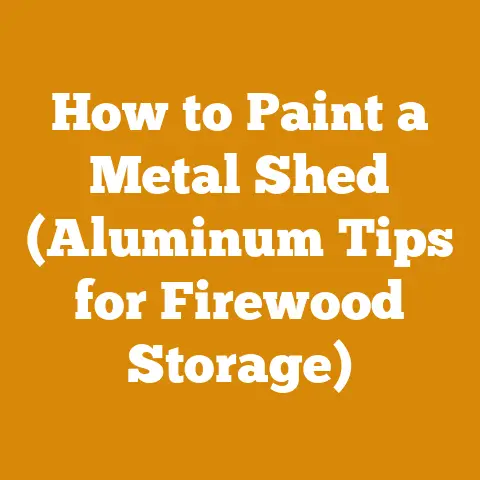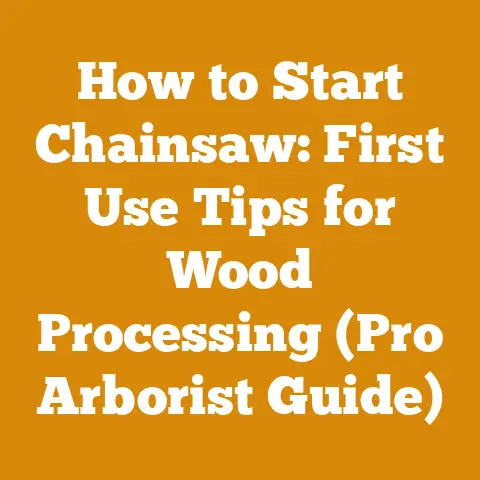Wood Stove Back Puffing Explained (7 Pro Tips for Safe Use)
I’ve relied on them for heating my home, cooking meals during power outages, and even just enjoying the cozy ambiance on a cold winter night. But, like any powerful tool, a wood stove demands respect and understanding. One of the most unsettling experiences a wood stove owner can face is “back puffing” – that sudden burst of smoke and potentially dangerous gases that escapes from the stove into your living space.
I remember one particularly chilly evening a few years back. I had just loaded up my stove with what I thought was well-seasoned oak, settled into my favorite armchair with a book, and was enjoying the radiating warmth. Suddenly, whoosh! A cloud of smoke billowed out from around the door, setting off the smoke alarm and filling the room with an acrid smell. Talk about a rude awakening!
That incident sparked a deep dive into understanding the causes and prevention of wood stove back puffing. Over the years, through research, experimentation, and plenty of trial and error (and a few more smoky surprises), I’ve learned a lot about how to mitigate this problem. I’m going to share my accumulated knowledge and provide you with seven pro tips for safe wood stove use, specifically aimed at preventing and managing back puffing.
Wood Stove Back Puffing Explained (7 Pro Tips for Safe Use)
Understanding the Beast: What is Back Puffing?
Back puffing, also known as “reverse puffing” or “negative pressure puffing,” occurs when the natural draft in your chimney reverses, causing smoke and combustion gases to be pushed back into your home instead of being drawn up and out. This isn’t just a nuisance; it can be a serious safety hazard. Those gases contain carbon monoxide, a colorless, odorless, and potentially deadly gas.
-
The Science Behind the Puff: Think of your chimney as a giant straw. Normally, hot air rises, creating a draft that pulls smoke and gases up and out. Back puffing happens when this natural flow is disrupted, and the pressure inside your home becomes lower than the pressure outside, essentially reversing the direction of the draft.
-
Data Point: According to the U.S. Environmental Protection Agency (EPA), improperly maintained wood stoves and chimneys are a significant source of indoor air pollution, contributing to respiratory problems and increasing the risk of carbon monoxide poisoning.
Why Does it Happen? Common Causes of Back Puffing
Back puffing can stem from a variety of factors, often working in combination. Understanding these causes is the first step in preventing the problem.
-
Cold Chimney: A cold chimney is a prime suspect. When the chimney is cold, the air inside is denser than the air in your home, making it difficult to establish an upward draft.
- My Experience: I’ve found that starting a fire in a cold chimney on a particularly frigid day is almost guaranteed to result in some back puffing, at least initially.
-
Negative Air Pressure in the House: Modern, tightly sealed homes are great for energy efficiency, but they can also create negative air pressure. This happens when exhaust fans (kitchen, bathroom), clothes dryers, and even forced-air heating systems draw air out of the house, creating a vacuum that pulls air down the chimney.
- Insight: A tight house is a double-edged sword. While it keeps the warmth in, it can also starve your wood stove of the necessary airflow.
-
Obstructions in the Chimney: Bird nests, creosote buildup, or even debris from falling branches can block the chimney, restricting airflow and causing back puffing.
- Case Study: A neighbor of mine experienced severe back puffing one winter. After a costly chimney inspection, they discovered a large bird nest blocking almost half of the flue.
-
Poor Chimney Design or Installation: An undersized chimney, a chimney that’s too short, or one that has too many bends can impede airflow and contribute to back puffing.
- Technical Detail: Chimney height should extend at least 3 feet above the highest point where it passes through the roof and at least 2 feet higher than any portion of a building within 10 feet.
-
Weather Conditions: Strong winds, especially those blowing across the top of the chimney, can disrupt the draft and cause back puffing.
- Personal Story: I live in an area prone to high winds. On particularly windy days, I often have to adjust the air intake on my stove to compensate for the increased pressure.
-
Damp Wood: Wet or unseasoned wood requires more energy to burn, resulting in cooler combustion temperatures and more smoke. This can overwhelm the chimney’s draft capacity.
- Data Point: Seasoned wood should have a moisture content of 20% or less. Using a wood moisture meter is a worthwhile investment.
Pro Tip #1: Prime the Chimney
The best way to combat a cold chimney is to warm it up before starting a full fire. This helps establish a proper draft.
-
How To: Before loading the stove with wood, roll up a few sheets of newspaper, light them, and hold them near the top of the firebox, allowing the hot air to rise into the chimney. You can also use a propane torch or a small amount of kindling for the same purpose.
-
My Method: I typically crumple up a couple of newspaper pages, light them, and hold them high in the firebox for a minute or two. You should feel the draft start to pull the smoke upwards.
-
Why It Works: Priming warms the air in the chimney, reducing the density difference between the inside and outside air, thus encouraging an upward draft.
Pro Tip #2: Crack a Window (The Controlled Leak)
Counteract negative air pressure by providing an alternative source of air for your wood stove.
-
The Technique: Open a window slightly in the same room as the wood stove. This allows air to enter the house without being drawn down the chimney.
-
Important Note: Don’t open the window too wide, as this can cool the room excessively. A small crack is usually sufficient.
-
Data Point: Experiment to find the optimal window opening. I’ve found that even a quarter-inch crack can make a significant difference in draft performance.
-
My Experience: I’ve noticed a dramatic reduction in back puffing incidents since I started cracking a window when using my stove, especially when the clothes dryer is running.
Pro Tip #3: Burn Seasoned Wood, Always!
Using properly seasoned wood is crucial for efficient combustion and minimizing smoke.
-
What is Seasoned Wood? Seasoned wood has been air-dried for at least six months, ideally longer. This reduces the moisture content, allowing it to burn hotter and cleaner.
-
How to Tell: Seasoned wood is typically darker in color, has cracks in the end grain, and sounds hollow when struck against another piece of wood.
-
The Moisture Meter’s Role: Invest in a wood moisture meter. Aim for a moisture content of 20% or less.
-
Data Point: Burning unseasoned wood can reduce heating efficiency by as much as 50% and significantly increase creosote buildup in the chimney.
-
Wood Selection Insight: Different wood species season at different rates. Softwoods like pine dry faster than hardwoods like oak.
-
Personal Story: I once tried to save money by burning wood that I thought was seasoned but turned out to be too damp. The resulting creosote buildup required a professional chimney cleaning and a stern lecture from the chimney sweep!
Pro Tip #4: Regular Chimney Inspections and Cleaning
A clean and well-maintained chimney is essential for safe and efficient wood stove operation.
-
Frequency: Have your chimney inspected and cleaned at least once a year, or more frequently if you burn wood regularly.
-
The Professional Touch: Hire a qualified chimney sweep to perform the inspection and cleaning. They have the tools and expertise to identify and address potential problems.
-
Creosote: The Silent Threat: Creosote is a highly flammable substance that builds up in the chimney as a byproduct of incomplete combustion. Regular cleaning removes creosote and reduces the risk of a chimney fire.
-
DIY Inspection (With Caution): If you’re comfortable doing so, you can perform a visual inspection of your chimney from the ground. Look for signs of damage, such as cracks or missing bricks.
-
Data Point: The National Fire Protection Association (NFPA) estimates that chimney fires are a leading cause of residential fires in the United States.
-
My Routine: I schedule a professional chimney inspection and cleaning every spring, after the heating season is over. This ensures that my stove is ready for the next winter.
Pro Tip #5: Proper Wood Stove Operation
How you operate your wood stove can significantly impact its performance and safety.
-
Air Control is Key: Adjust the air intake on your stove to control the rate of combustion. Too much air can cause the fire to burn too hot, while too little air can lead to smoldering and increased smoke production.
-
Top-Down Burning (My Preferred Method): Instead of starting the fire at the bottom, try the top-down burning method. Place larger logs at the bottom, followed by kindling and tinder on top. This creates a cleaner, more efficient burn.
-
Avoid Overloading: Don’t overload the firebox with wood. This can restrict airflow and lead to incomplete combustion.
-
Understanding Your Stove: Read the manufacturer’s instructions carefully and follow their recommendations for optimal operation.
-
Real-World Example: I switched to top-down burning a few years ago and noticed a significant reduction in smoke and creosote buildup. It also seems to require less tending.
Pro Tip #6: Install a Carbon Monoxide Detector
This is non-negotiable. A carbon monoxide detector is a crucial safety device that can alert you to the presence of this deadly gas.
-
Placement Matters: Install carbon monoxide detectors on every level of your home, especially near sleeping areas.
-
Regular Testing: Test the detectors regularly to ensure they are functioning properly.
-
Battery Backup: Choose detectors with battery backup in case of a power outage.
-
Data Point: Carbon monoxide poisoning is a leading cause of accidental death in the United States.
-
My Safety Net: I have multiple carbon monoxide detectors in my home, and I test them every month. It’s a small price to pay for peace of mind.
Pro Tip #7: Consider a Chimney Cap with a Draft Enhancer
A chimney cap protects your chimney from the elements and can also improve draft performance. A draft enhancer takes it a step further.
-
The Cap’s Role: A chimney cap prevents rain, snow, and debris from entering the chimney. It also helps to prevent downdrafts caused by wind.
-
Draft Enhancers: These are mechanical devices that attach to the top of the chimney and use a fan to actively pull air up the flue. They can be particularly helpful in homes with poor chimney design or those located in windy areas.
-
Research is Essential: If you’re considering a draft enhancer, do your research and choose a model that is appropriate for your wood stove and chimney.
-
Cost vs. Benefit: Draft enhancers can be expensive, but they can also significantly improve draft performance and reduce back puffing.
-
My Future Project: I’m considering installing a draft enhancer on my chimney to further improve draft performance and reduce the risk of back puffing, especially on windy days. I am still researching different models and weighing the costs and benefits.
Beyond the Basics: Wood Species and Their Impact
The type of wood you burn can also affect back puffing. Different wood species have different densities, moisture contents, and burning characteristics.
-
Hardwoods vs. Softwoods: Hardwoods, such as oak, maple, and ash, are generally denser and burn longer and hotter than softwoods, such as pine, fir, and spruce.
-
Resin Content: Softwoods contain more resin than hardwoods, which can contribute to creosote buildup.
-
Ideal Choices: For optimal burning performance, I recommend using seasoned hardwoods. Oak is my personal favorite, as it burns long and hot.
-
Softwood Considerations: If you do burn softwoods, burn them in smaller quantities and more frequently to prevent excessive creosote buildup.
-
Data Point: A cord of seasoned oak contains approximately 24 million BTUs of energy, while a cord of seasoned pine contains approximately 17 million BTUs.
Troubleshooting Common Back Puffing Scenarios
Even with the best preparation, back puffing can still occur. Here are some common scenarios and how to address them:
-
Scenario 1: Back Puffing When Starting a Fire: This is often due to a cold chimney. Prime the chimney thoroughly before adding wood.
-
Scenario 2: Back Puffing During Windy Conditions: Adjust the air intake on your stove to compensate for the increased pressure. Consider installing a chimney cap with a draft enhancer.
-
Scenario 3: Back Puffing After Adding Wood: This could be due to damp wood. Ensure that your wood is properly seasoned.
-
Scenario 4: Sudden, Unexpected Back Puffing: This could indicate a blockage in the chimney. Extinguish the fire immediately and have the chimney inspected.
The Importance of Patience and Observation
Using a wood stove safely and efficiently requires patience and careful observation. Pay attention to how your stove is performing and make adjustments as needed.
-
Listen to Your Stove: Learn to recognize the sounds of a healthy fire. A roaring fire is generally a good sign, while a smoldering fire can indicate a problem.
-
Watch the Smoke: Observe the color and density of the smoke coming from your chimney. Clear, thin smoke is ideal, while thick, dark smoke indicates incomplete combustion.
-
Experiment and Learn: Don’t be afraid to experiment with different wood types, burning techniques, and air intake settings. The more you learn about your stove, the better you’ll be able to operate it safely and efficiently.
The Global Perspective: Challenges Faced by Wood Stove Users Worldwide
Wood stoves are used in many parts of the world, often as a primary source of heat. However, users in different regions face unique challenges.
-
Developing Countries: In many developing countries, wood stoves are often used for cooking as well as heating. These stoves are often inefficient and produce high levels of indoor air pollution.
-
Remote Areas: In remote areas, access to seasoned wood can be limited. Users may be forced to burn whatever wood is available, regardless of its moisture content.
-
Regulatory Differences: Regulations regarding wood stove emissions and chimney maintenance vary widely from country to country.
Final Thoughts: Embrace the Warmth, Respect the Fire
Wood stoves offer a unique combination of warmth, comfort, and self-reliance. By understanding the causes of back puffing and following these pro tips, you can enjoy the benefits of a wood stove without compromising your safety. Remember, a little knowledge and preparation can go a long way in ensuring a safe and enjoyable wood-burning experience.






